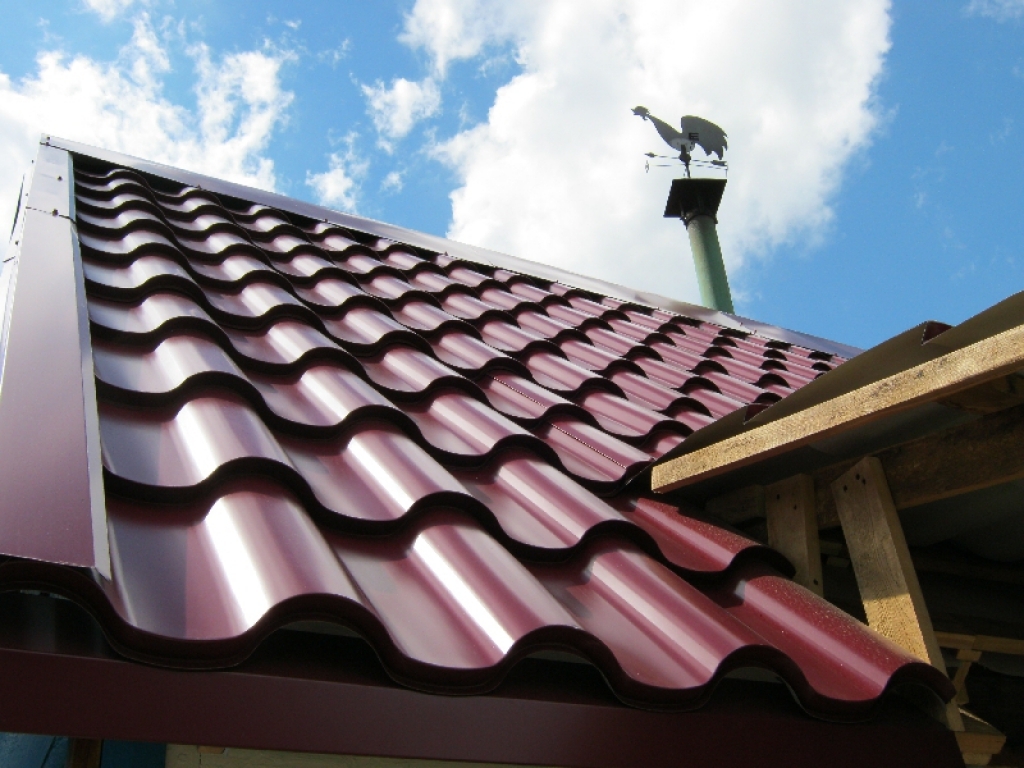Measuring current clamp - everything you wanted to know about this device
Table of contents
-
1 What can I use measuring tongs
- 1.1 Varieties clamp
- 1.2 Apparatus current clamp
- 1.3 Principle of operation
- 1.4 How to use the tongs
- 2 conclusion
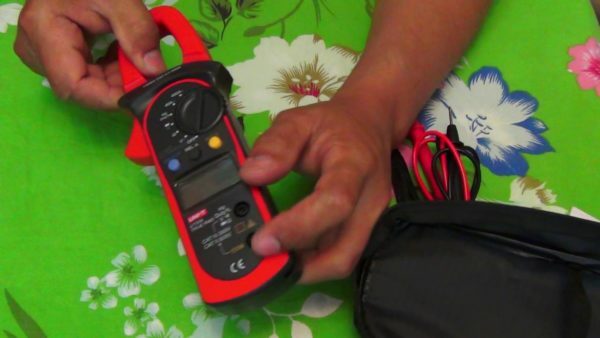
Clamp Meter must be set every electrician.
You plan to do their own electrical work? To do this you will need current clamp AC, which allow to carry out all the necessary measurements in the home wiring. I'll tell you how they work and what is needed, and as well as I will describe in detail how to work with this device.
What can I use measuring tongs
Modern clamp meter, in fact can be considered as a multimeter. This tool allows you to measure not only the current, but also to identify many other electrical parameters:
- The presence or absence of a phase in the network;
- DC and AC;
- Resistance of the circuit;
- Resistance and breakdown of electrical insulation;
- An open or short circuit in the electrical circuit;
- Power consumption of electrical appliances;
- The actual load on the supply line or the opening in the electrical machine.
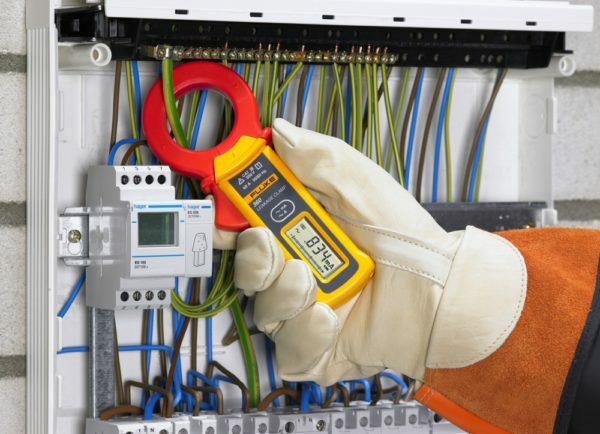
Current measurement circuit in a protective grounding reveals leakage to ground voltage.
Induction pliers current measurements allow to perform measurements on an insulated conductor even without breaking the electrical circuit. The main condition is that through the magnetic frame must pass only one conductor - or phase, or zero.
Varieties clamp
To know what current clamp opt for a home workshop, you need to understand that they differ not only in appearance. Different models may have significant functional differences, such as:
- Indicator - can be analog or digital:
- The analog indicator readings are displayed on the pointer instruments. Such devices are cheaper, but they are less convenient because they have less functionality;
- Digital indicators display information in a more convenient form, but are a bit more expensive, but for their work necessarily requires a battery.
- Measurement parameters:
- The simplest models can only measure the current in the AC mains voltage;
- Devices of midrange allow the measurement voltage and the AC and DC, as well as resistance to a short circuit in the electrical circuit;
- More expensive models, in addition to the basic measurements, may have a number of additional functions, such as digital thermometer with an external temperature sensor, tester for diodes and transistors and so forth.
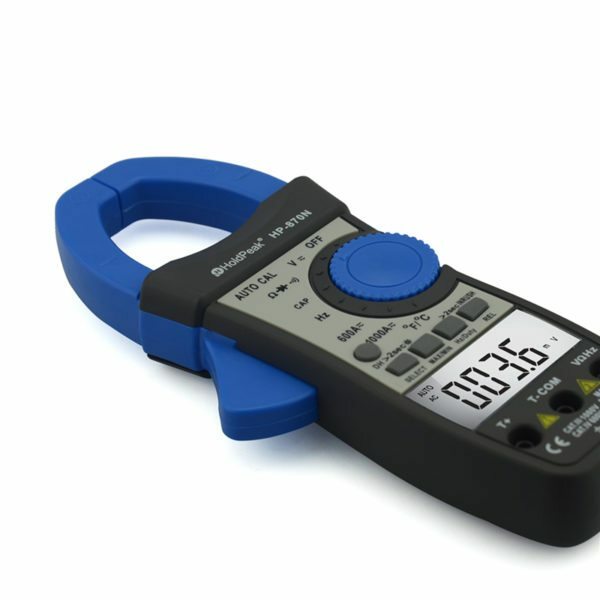
Such a device with an external temperature sensor can measure temperature in degrees Celsius or Fahrenheit.
Apparatus current clamp
Typically pliers for measuring current in a plastic housing made and sold in a soft cover made of cloth. The package also includes a user manual and wires with plastic tips, and the batteries need to be purchased separately.
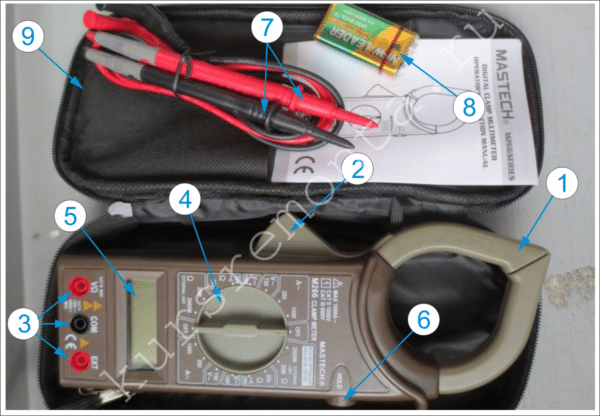
The photo shows the instrument controls and accessories, and detailed decoding digital footnotes described below.
Pliers for measuring the current comprise the following elements:
- magnetic circuit It made of metal, plastic-coated to form interlocking hinge mites;
- disclosing keymagnetic flap. Pressed to pass through a current conducting cable yoke;
- connectors - are used to connect wires to the test leads. Black jack - general, and red are used depending on the type of measurement;
- thumbwheel - is used to select measurement modes;
- LCD screen - is used to output digital information. Some models are equipped with a screen with backlight;
- measurements locking key in memory. It applies in the case when, during the measurement you do not see readings on the digital display. After pressing, they remain on the screen;
- Wires with plastic measuring probes. Used for measuring the resistance, the DC and AC voltages as well as other electrical parameters;
- A constant current source (Penlight batteries of AA or crown);
- cloth bag - used for storage and transportation of the device.
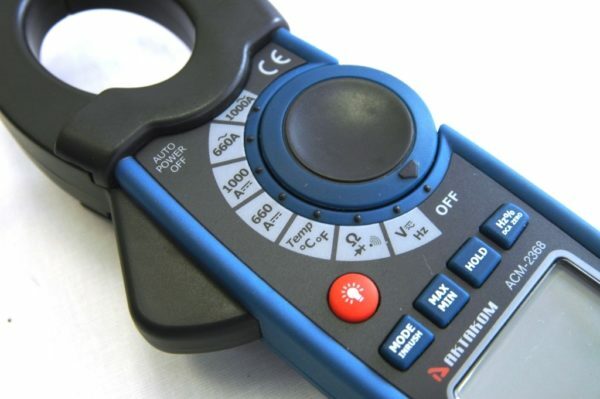
When choosing a tick it is important to pay attention to ergonomics and ease of use.
Principle of operation
All such devices for measuring alternating current work on the principle of the transformer with one winding, and the magnetic function it performs detachable frame mites:
- primary this transformer - a busbar bus or electrical cable to which you are measuring the current strength;
- secondary winding It is located inside the device. She wrapped a thin wire with many turns around the split magnetic frame;
- Ammeter - an indicator device which directly indicates the value of current intensity:
- In analog devices arrow ammeter is connected in series to the secondary winding of the transformer;
- In digital devices signal supplied to the secondary winding electronic transformer which calculates and outputs the current value of the force on the LCD screen.
- Measuring AC is performed on the principle of electromagnetic induction:
- During the measurement the current-carrying conductor must be within the scope of the closed magnetic circuit;
- When passing an alternating electric current through a conductor in the magnetic induction induced voltage;
- Due to electromagnetic induction, electric current passes to the secondary winding, in which its power is measured by an ammeter.

During the measurement, the instrument through the frame should pass only one conductor.
Principle only for the measurement of AC power, you can use electromagnetic induction. All other electrical parameters are measured using test leads with remote isolated probes.
How to use the tongs
Below is illustrated instruction manual. In it, I'll tell you how to properly use a clamp meter to measure the main parameters and fault finding in the household electric system:
| Illustration | measurement |
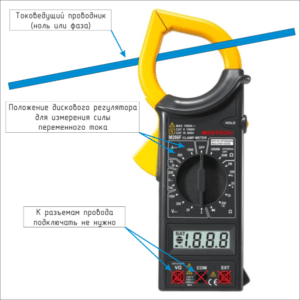 |
AC measurement:
|
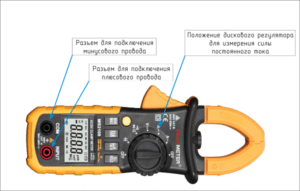 |
DC measurement:
When measuring current, the parallel connection of the device to the network is strictly prohibited! |
 |
Voltage measurement:
To measure the voltage is always applied only to the parallel connection of the device to the network. |
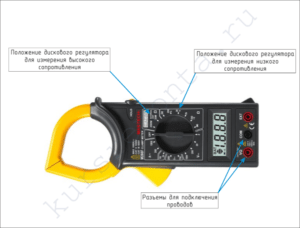 |
Resistance measurement:
Resistance is always measured in parallel to the load, and the polarity of the wires has no value. |
 |
Determination of an open or short circuit:
|
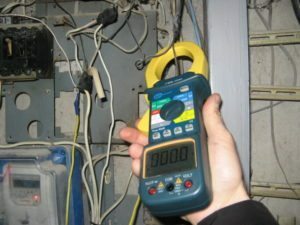 |
Determining Power Consumption. If you suspect that someone from the neighbors connected to your cable, it is easy to check with their own hands:
|
If you need to perform measurements in a circuit with a very small current strength, I advise you to do so: in the frame of the magnetic wind five or ten turns of the current-carrying conductor and measure the current. The resulting value on the display is to be divided by the number of turns (5 or 10).
conclusion
Now that you know how to choose the current clamps, and how to use them correctly when performing electrical work. I advise to pay attention to the video in this article, but all suggestions and questions leave me in the comments.

